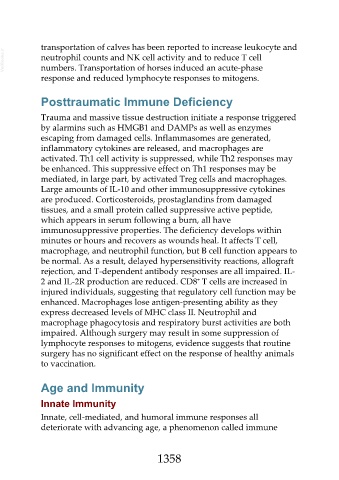Page 1358 - Veterinary Immunology, 10th Edition
P. 1358
transportation of calves has been reported to increase leukocyte and
VetBooks.ir neutrophil counts and NK cell activity and to reduce T cell
numbers. Transportation of horses induced an acute-phase
response and reduced lymphocyte responses to mitogens.
Posttraumatic Immune Deficiency
Trauma and massive tissue destruction initiate a response triggered
by alarmins such as HMGB1 and DAMPs as well as enzymes
escaping from damaged cells. Inflammasomes are generated,
inflammatory cytokines are released, and macrophages are
activated. Th1 cell activity is suppressed, while Th2 responses may
be enhanced. This suppressive effect on Th1 responses may be
mediated, in large part, by activated Treg cells and macrophages.
Large amounts of IL-10 and other immunosuppressive cytokines
are produced. Corticosteroids, prostaglandins from damaged
tissues, and a small protein called suppressive active peptide,
which appears in serum following a burn, all have
immunosuppressive properties. The deficiency develops within
minutes or hours and recovers as wounds heal. It affects T cell,
macrophage, and neutrophil function, but B cell function appears to
be normal. As a result, delayed hypersensitivity reactions, allograft
rejection, and T-dependent antibody responses are all impaired. IL-
+
2 and IL-2R production are reduced. CD8 T cells are increased in
injured individuals, suggesting that regulatory cell function may be
enhanced. Macrophages lose antigen-presenting ability as they
express decreased levels of MHC class II. Neutrophil and
macrophage phagocytosis and respiratory burst activities are both
impaired. Although surgery may result in some suppression of
lymphocyte responses to mitogens, evidence suggests that routine
surgery has no significant effect on the response of healthy animals
to vaccination.
Age and Immunity
Innate Immunity
Innate, cell-mediated, and humoral immune responses all
deteriorate with advancing age, a phenomenon called immune
1358

